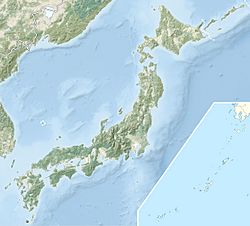869 Jōgan earthquake facts for kids
| Local date | 13 July 869 |
|---|---|
| Magnitude | 8.6–9.0 Mw |
| Epicenter | 38°30′N 143°48′E / 38.5°N 143.8°E |
| Type | Megathrust |
| Areas affected | Miyagi Prefecture, Japan |
| Tsunami | Yes |
| Casualties | ≈1,000 |
The 869 Jōgan earthquake and its huge tsunami hit the area near Sendai in northern Honshu, Japan. This happened on July 13, 869. Scientists believe the earthquake was very strong, possibly between 8.6 and 9.0 on the moment magnitude scale. This is similar to the massive 2011 Tōhoku earthquake and tsunami. The tsunami caused a lot of flooding across the Sendai plain. In 2001, scientists found sand from this ancient tsunami over 4.5 kilometers (about 2.8 miles) away from the coast.
Contents
What's in a Name?
In Japan, this earthquake is often called "Jōgan Jishin." "Jōgan" is the name of the time period (or era) in Japanese history from 859 to 877 AD. Other big earthquakes also happened during this era. So, people sometimes add the name of the place where the earthquake started, like Sanriku, and the year it happened. Sanriku is a coastal area in northeastern Honshu, facing the Pacific Ocean. An old Japanese history book called Nihon Sandai Jitsuroku, written in 901, recorded details about the 869 earthquake and tsunami in Mutsu Province.
An Old Story of the Disaster
Even though this earthquake happened far from Japan's ancient capital, Kyoto, official records still described the event. The book Nihon Sandai Jitsuroku (which means "True History of Three Reigns of Japan") tells us what happened:
|
五月廿六日癸未 陸奧國地大震動 流光如晝隱映 頃之 人民叫呼 伏不能起 或屋仆壓死 或地裂埋殪 馬牛駭奔 或相昇踏 城(郭)倉庫 門櫓墻壁 頽落顛覆 不知其數 海口哮吼 聲似雷霆 驚濤涌潮 泝洄漲長 忽至城下 去海數十百里 浩々不辨其涯諸 原野道路 惣爲滄溟 乘船不遑 登山難及 溺死者千許 資産苗稼 殆無孑遺焉 |
On July 13, 869 AD, a huge earthquake shook Mutsu province. Strange lights appeared in the sky. People screamed and cried, falling to the ground. Some were killed by collapsing houses, others by cracks in the earth. Horses and cattle ran wild, trampling each other. Many buildings, warehouses, gates, and walls were destroyed. |
Why Earthquakes Happen Here
Northern Honshu sits where two huge pieces of the Earth's crust, called plates, meet. The Okhotsk Plate is pushing over the Pacific Plate, which is sliding underneath it. This area is known for many large earthquakes. These quakes can happen when the plates rub against each other or when they bend and break. Many of these earthquakes have caused destructive tsunamis, like the 1896 Sanriku earthquake.
Damage from the Disaster
At the time of the earthquake, the Japanese Imperial Court was fighting with the Emishi, an native group in the Tōhoku region. According to the old book Nihon Sandai Jitsuroku, about 1,000 people died because of the tsunami. There are also old stories about the earthquake from the Tōhoku region all the way to the Bōsō Peninsula.
The tsunami caused widespread flooding on the Sendai plain. It reached at least 4 kilometers (about 2.5 miles) inland. The town of Tagajō and its castle were destroyed. Scientists have found the remains of 8th and 9th-century buildings under the town, covered by layers of sediment from the mid-10th century.
How Strong Was It?
The Earthquake's Power
Scientists first estimated the earthquake's strength at 8.6 by studying the tsunami it caused. They thought the area that broke underground was about 200 kilometers (124 miles) long and 85 kilometers (53 miles) wide, with the ground moving about 2 meters (6.5 feet).
However, after the 2011 Tōhoku earthquake and tsunami, scientists looked at the sand deposits from the 869 tsunami again. They realized the earlier studies might have underestimated how far the water went inland. A muddy layer was found even further inland than the sand. Since the land in Sendai hasn't changed much since 869, it's now thought that the 2011 and 869 tsunamis were similar in size. This means the 869 earthquake might have been much stronger than first thought, possibly as high as 9.0.
The Tsunami's Reach
Scientists have mapped how far the 869 tsunami flooded the Sendai plain by studying layers of sand it left behind. The tsunami flooded at least 4 kilometers (2.5 miles) inland. The areas that were flooded in 869 were very similar to those flooded by the 2011 Tōhoku earthquake and tsunami.
Future Earthquake Risk
Scientists have found three layers of tsunami deposits in the Sendai plain from the last 3,000 years. This suggests that very large tsunamis hit this area every 800 to 1,100 years. In 2001, experts warned that there was a high chance of another big tsunami hitting the Sendai plain, as more than 1,100 years had passed since the 869 event.
Before the 869 tsunami, two other large tsunamis occurred around 1000 BC to 500 BC and around 1 AD. In 2007, scientists estimated a 99% chance of an earthquake with a magnitude of 8.1–8.3 happening in the next 30 years. The 2011 Tōhoku earthquake then happened in almost the same area as the 869 earthquake. This fulfilled the prediction and caused major flooding in the Sendai area once again.
See also
- List of earthquakes in Japan
- List of historical earthquakes
- Seismicity of the Sanriku coast
- 1454 Kyōtoku earthquake and tsunami


